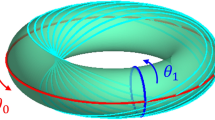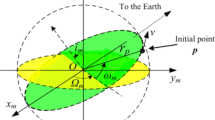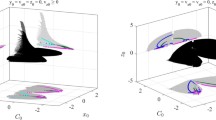Abstract
In recent years, three-dimensional periodic and quasi-periodic orbits near the collinear libration points in the Sun-Earth/Moon three-body problem have been the focus of great interest for space mission design. Thus, more effort in the astrodynamics community has been directed toward analysis and computation of families of such orbits. But families of periodic orbits in the three-body problem have been the subject of much study for many decades. The first such orbit to be employed for a spacecraft trajectory (ISEE-3) was a member of a particular type of simply symmetric three-dimensional family, i.e., a halo orbit. Thus, attention shifted to further analysis of these periodic halo families. Some of the significant work in the development of periodic solutions in the three-body problem has been reviewed and a number of the highlights from the analysis and eventual numerical computation of halo families is presented here. The halo families of periodic orbits extend from each of the libration points to the nearest primary; they appear to exist for all values of the mass ratio. Thus, this further understanding may serve to support future spacecraft mission planning as well.
Similar content being viewed by others
References
HOWELL, K. C. and FARQUHAR, R. W. “John Breakwell, the Restricted Problem, and Halo Orbits,” Acta Astronautica, Vol. 29, No. 6, 1993, pp. 485–488.
FARQUHAR, R. W. “Station-Keeping in the Vicinity of Collinear Libration Points with an Application to a Lunar Communications Problem,” Space Flight Mechanics, Vol. 11, Science and Technology Series, American Astronautical Society, New York, 1967, pp. 519–535.
FARQUHAR, R. W. and KAMEL, A. A. “Quasi-Periodic Orbits About the Translunar Libration Point,” Celestial Mechanics, Vol. 7, 1973, pp. 458–473.
FARQUHAR, R. W. “The Control and Use of Libration Point Satellites,” NASA TR T-346, 1970.
POINCARÉ, H. Les Méthodes Nouvelles de la Mécanique Céleste, Vol. I, 1892; New Methods of Celestial Mechanics (English Translation), Vol. 13, History of Modern Physics and Astronomy, American Institute of Physics, 1993.
MOULTON, F. R. Periodic Orbits, Carnegie Institution of Washington Publications, No. 161, Washington, 1920.
SZEBEHELY, V. Theory of Orbits: The Restricted Problem of Three Bodies, Academic Press, New York, 1967.
GOUDAS, C. L. “Three-Dimensional Periodic Orbits and Their Stability,” Icarus, Vol. 2, 1963, pp. 1–18.
BRAY, T. A. and GOUDAS, C. L. “Three-Dimensional Periodic Oscillations about L1, L2, and L3,” Advances in Astronomy and Astrophysics (Z. Kopal, Editor), Vol. 5, Academic Press, New York, 1967, pp. 71–130.
HÉNON, M. “Vertical Stability of Periodic Orbits in the Restricted Problem, I. Equal Masses,” Astronomy and Astrophysics, Vol. 28, 1973, pp. 415–426.
KAZANTZIS, P. G. “The Structure of Periodic Solutions in the Restricted Problem of Three Bodies: Sun-Jupiter Case,” Astrophysics and Space Science, Vol. 59, 1978, pp. 355–371.
ROBIN, I. A. and MARKELLOS, V. V. “Numerical Determination of Three-Dimensional Periodic Orbits Generated from Vertical Self-Resonant Satellite Orbits,” Celestial Mechanics, Vol. 21, 1980, pp. 395–434.
MICHALODIMITRAKIS, M. “A New Type of Connection Between Families of Periodic Orbits of the Restricted Problem,” Astronomy and Astrophysics, Vol. 64, 1978, pp. 83–86.
ICHTIAROGLOU, S. S. and MICHALODIMITRAKIS, M. “Three-Body Problem: The Existence of Families of Three-Dimensional Periodic Orbits which Bifurcate from Planar Periodic Orbits,” Astronomy and Astrophysics, Vol. 81, 1980, pp. 30–32.
ZAGOURAS, C. G. and KAZANTZIS, P. G. “Three-Dimensional Periodic Oscillations Generating from Plane Periodic Ones Around the Collinear Lagrangian Points,” Astrophysics and Space Science, Vol. 61, 1979, pp. 389–409.
MARCHAL, C. The Three-Body Problem, Elsevier Science Publishing Company, New York, 1990.
BARDEN, B. T. and HOWELL, K. C. “Fundamental Motions Near Collinear Libration Points and Their Transitions,” Journal of the Astronautical Sciences, Vol. 46, No. 4, October– December 1998, pp. 361–378.
BARDEN, B. T. and HOWELL, K. C. “Formation Flying in the Vicinity of Libration Point Orbits,” Paper No. AAS 98-169, AAS/AIAA Space Flight Mechanics Meeting, Monterey, California, February 1998.
HOWELL, K. C. and PERNICKA, H. J. “Numerical Determination of Lissajous Trajectories in the Restricted Three-Body Problem,” Celestial Mechanics, Vol. 41, Nos. 1–4, 1988, pp. 107– 124.
GÓMEZ, G., JORBA, À, MASDEMONT, J., and SIMÓ, C. “Study Refinement of Semianalytical Halo Orbit Theory,” Final Report, ESOC Contract No. 8625/89/D/MD(SC), 1991.
SIMÓ, C. “Effective Computations in Hamiltonian Dynamics,” in Cent ans après les Méthodes Nouvelles de H. Poincaré, Société Mathématique de France, 1996, pp. 1–23.
GÓMEZ, G., MASDEMONT, J., and SIMÓ, C. “Lissajous Orbits Around Halo Orbits,” Paper No. 97-106, AAS/AIAA Spaceflight Mechanics Meeting, Huntsville, Alabama, February 1997.
FARQUHAR, R. W., MUHONEN, D. P., and RICHARDSON, D. L. “Mission Design for a Halo Orbiter of the Earth,” Journal of Spacecraft and Rockets, Vol. 14, 1977, pp. 170–177.
RICHARDSON, D. L. “Halo-Orbit Formulation for the ISEE-3 Mission,” Journal of Guidance and Control, Vol. 3, No. 6, November–December 1980, pp. 543–548.
BREAKWELL, J.V. and BROWN, J. V. “The ‘Halo’ Family of 3-Dimensional Periodic Orbits in the Earth-Moon Restricted 3-Body Problem,” Celestial Mechanics, Vol. 20, 1979, pp. 389–404.
HOWELL, K. C. “Three-Dimensional, Periodic, ‘Halo’ Orbits,” Celestial Mechanics, Vol. 32, 1984, pp. 53–71.
BREAKWELL, J.V. and HOWELL, K.C. “Almost Rectilinear Halo Orbits,” Celestial Mechanics, Vol. 32, 1984, pp. 29–52.
HOWELL, K. C. and CAMPBELL, E. T. “Families of Periodic Orbits that Bifurcate from Halo Families in the Circular Restricted Three-Body Problem,” Paper No. AAS 99-161, AAS/AIAA Spaceflight Mechanics Conference, Breckenridge, Colorado, February 1999.
GÓMEZ, G., JORBA, À., MASDEMONT, J., and SIMÓ, C. “Study of the Transfer from the Earth to a Halo Orbit Around the Equilibrium Point L1,” Celestial Mechanics and Dynamical Astronomy, Vol. 56, No. 4, 1993, pp. 541–562.
HOWELL, K. C., BARDEN, B. T., and LO, M. W. “Application of Dynamical Systems Theory to Trajectory Design for a Libration Point Mission,” Journal of the Astronautical Sciences, Vol. 45, No. 2, April–June 1997, pp. 161–178.
GUZMÁN, J. J., COOLEY, D. S., HOWELL, K. C., and FOLTA, D. “Trajectory Design Strategies for Libration Point Missions that Incorporate Invariant Manifolds and SWINGBY,” Paper No. AAS 98-349, AAS/GSFC International Symposium on Space Flight Dynamics, Greenbelt, Maryland, May 1998.
Author information
Authors and Affiliations
Rights and permissions
About this article
Cite this article
Howell, K.C. Families of Orbits in the Vicinity of the Collinear Libration Points. J of Astronaut Sci 49, 107–125 (2001). https://doi.org/10.1007/BF03546339
Published:
Issue Date:
DOI: https://doi.org/10.1007/BF03546339




